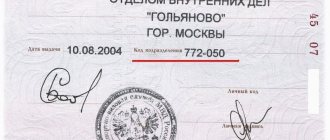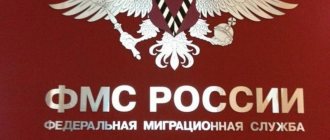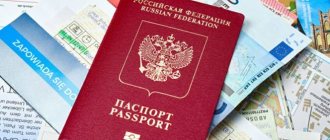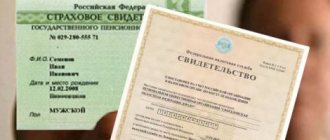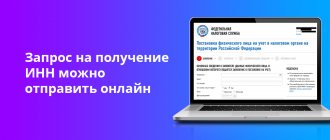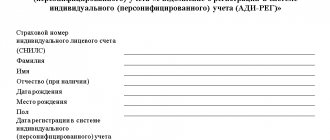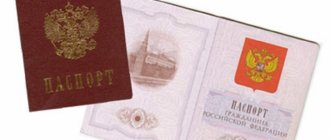Every person in any state has a national passport. Some also have a foreign document of a certain type, which is established by state migration authorities.
Since the passport form is subject to the strictest accounting, numbers are placed on it, perforations are applied, and on the page with personal data there is also a hologram displaying the letters of the Russian Federation and the state emblem to protect against counterfeiting.
Those who receive a passport for the first time (after reaching 14 years of age) should know what all the levels of protection on the passport mean, since this is the most important document from the moment of receipt. Protection is carried out in several ways, for example, such as a passport series by region or check digits in certain lines, which will be discussed below.
By law, your passport must be kept from damage and loss. For its improper use, a citizen bears administrative liability, which may result in the payment of a fine.
Passport replacement
In the event that a citizen needs to replace his passport due to any circumstances, he must provide documents to the migration service as soon as possible. According to the law, the application must take place no later than within a month from the moment such conditions arise to replace the passport.
The Administrative Code provides for violation of these terms in Article 19.15 with a fine of 2 to 5 thousand rubles.
It should be noted that a passport is replaced upon reaching a certain age, if it is damaged or lost, if the surname, first name or patronymic, gender are changed, or if inaccuracies are identified in the passport records.
Unlike a pension insurance certificate or TIN, when when they are replaced, the individual digital designations remain the same, in the new document the passport series and its number change.
Passport Series. Series and passport number. Passport series by region
Every person in any state has a national passport.
Some also have a foreign document of a certain type, which is established by state migration authorities. Since the passport form is subject to the strictest accounting, numbers are placed on it, perforations are applied, and on the page with personal data there is also a hologram displaying the letters of the Russian Federation and the state emblem to protect against counterfeiting.
Those who receive a passport for the first time (after reaching 14 years of age) should know what all the levels of protection on the passport mean, since this is the most important document from the moment of receipt. Protection is carried out in several ways, for example, such as a passport series by region or check digits in certain lines, which will be discussed below.
By law, your passport must be kept from damage and loss. For its improper use, a citizen bears administrative liability, which may result in the payment of a fine.
Second page
The designation of the passport form consists of 10 characters, which are arranged in blocks of 4 (series) and 6 (number) digits. These numbers are never repeated in full, except for the designation of the series and year of issue.
Passport series, that is, the initial four digits, the first two are the OKATO code of the issuing region.
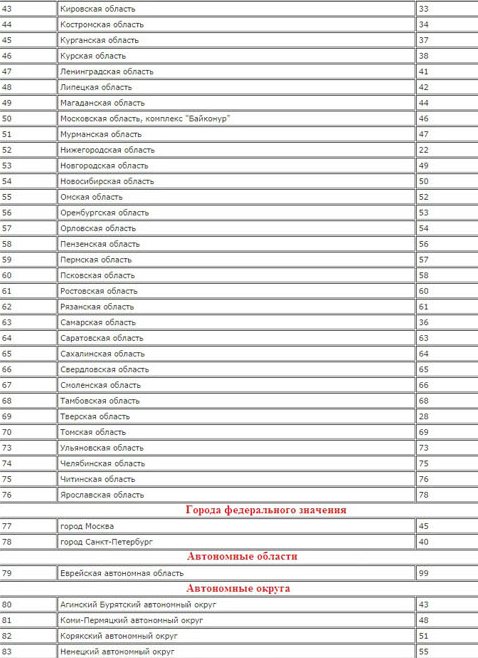
In the first block, the second two digits are the year the passport was issued. Sometimes this designation and the actual year of issue do not match. This does not mean that the passport is invalid, it’s just that the line of designations with the required numbers has ended, and Gosznak changed the series to one number.
The passport number is not associated with anything; each issued document is numbered in order.
Where to find data
When filling out the forms, you must indicate the series and number of your foreign passport. For people who rarely travel abroad, it can be difficult to navigate and figure out how many numbers to write. Let's take a closer look at the first page.
In the upper right corner of the page on which the photograph is posted, it is written in two languages: “Passport Number” and “Passport No”. Immediately below this inscription there is a digital designation. The two numbers shown at the beginning indicate the series. Next comes a space. The next seven characters are the number.
The passport number consists of nine digits; letters are not used.
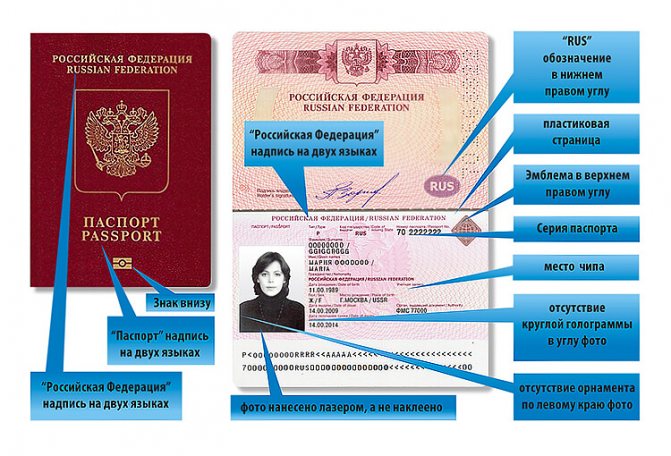
Control line
In addition to the fact that there is a series and number of the passport, the document also contains (on the third page) two lines at the bottom, under the photograph. This designation does not contain a readable chip, as many people think, but contains duplicate information about the passport.
The letter P means that this passport is machine readable, the next letter is N – the type of document (national). The next characters in the line are RUS. Accordingly, in addition to the fact that the series and number of the passport indicate the region of issue and affiliation with the Russian Federation, this information is additionally written in the duplicate line.
The following letters are the personal data (full name) of the passport holder, written in Latin letters using transliteration. Between the components and to the end of the top line, the sign “<<” is written, which replaces the space in the document.
The second line begins with the passport series being entered, but only the first three digits, and then the document number and check digit. For example, if the series and number are 3213 279750, then the line will indicate: 3212797506, where 6 is the control value.
This is followed by an indication of citizenship (RUS) and date of birth (year/month/date). Before the “<<” signs, the check digit and gender of the passport holder are written (M – male, F – female). For example: RUS8011299F.
After the space there is a final group of numbers, starting with the last digit that ends the passport series. The date of issue in international format and the department code are also indicated.
The duplicated information is completed by two check digits. Example: 3130614420055<80.
It should be noted that the control numbers do not contain any secret information. They only mean the accuracy of scanning such data as the owner’s personal data, number and series of the Russian passport. Example of control duplicate lines:
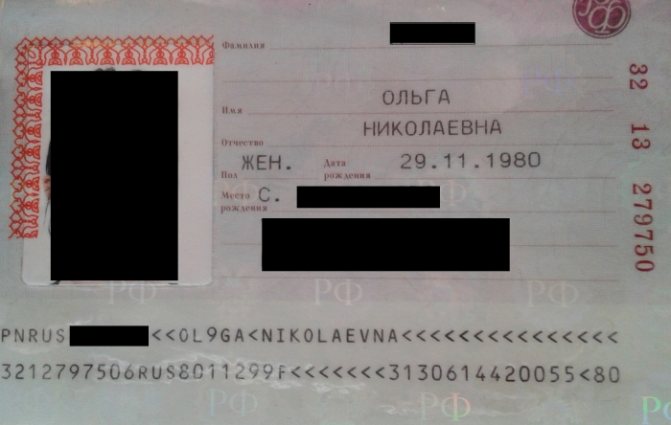
How to find out the series and number of the passport?
Information about the passport number and its series is indicated on the pages of the document itself. It is enough to open the first spread, where there are blocks of data about who issued the passport and when, as well as the citizen’s full name, date and place of birth. This is a block of two groups of numbers. The first group of 4 digits is the passport series, and the second of six digits is its number.
Where can I see the series and passport number?
You can view the passport number and series on its pages. These numbers are printed at the top or bottom of the pages, depending on the data blocks located there. On the photo spread, as well as on the last two pages for special marks No. 18 and 19, the number and series are printed at the top.
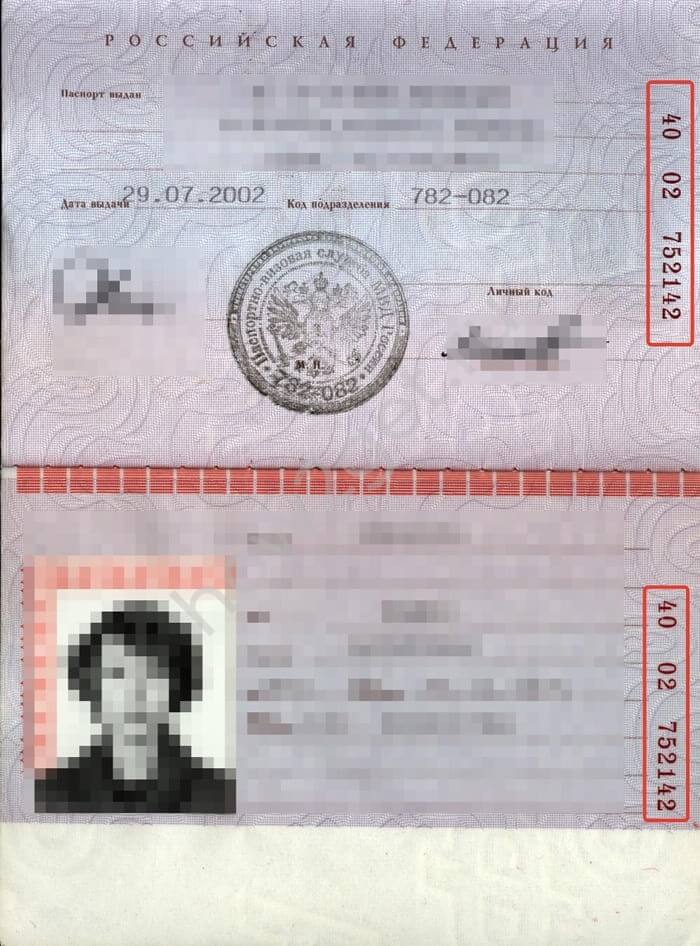
On the fifth, seventh, tenth, eleventh, fourteenth and sixteenth pages this identifier is located at the bottom. There are pages where the numbers and series are not printed at all - this is the title page of the passport, its very last page, as well as pages 4, 6, 8, 13, 15 and 17. Page 13 is intended to mark military duty, and spread 16-17 – to enter information about children. The remaining pages do not contain blocks for entering data.
Font and printing method
Until 2008, the series of the Russian passport, as well as the number, were applied in the printing house to all pages of the passport in the same way. After 2008, the typographic printing method remained unchanged on the second and third pages, and laser perforation began to be used on the remaining pages.
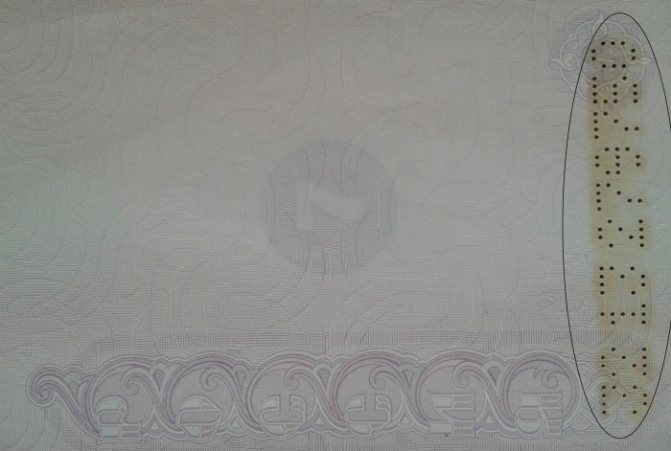
The font in which the digital identification of the passport is printed is unique. It is not used in any document. This is done in order to eliminate the possibility of counterfeiting. Although some people are able to pick up a similar font and use it for personal gain.
By the way, passport falsification is punishable by law, as noted in Article 327 of the Criminal Code of the Russian Federation.
In a new passport
Until 2008, only the typographic method of applying numbers was used to apply the number and series of the passport. After 2008, only the second and third pages of the passport are marked in this way. On the remaining pages, a laser perforation method is used to apply a digital document identifier. That is, the numbers are not printed, but burned into the paper using a laser beam. The output is a number consisting of small through holes. This method is an additional way to protect your passport from counterfeiting.
Residence permit and passport
The code and series of the passport of a foreign citizen who enters the territory of the Russian Federation to obtain citizenship looks a little different. The example shows that the digital designation is located not on the right, but on the left of the first (conditionally) page, and on the next - before writing the surname.

The series on a foreign passport is also written differently from how the series on a Russian passport is indicated. Example: 51№1402606.
All information is necessarily duplicated not only in the control line, but also after each word. Thus, the surname, first name, patronymic, place of birth and other information are indicated both in Russian letters and in transliteration.
Where did the line “Personal code” come from?
The line was included in the passport by Decree of the Government of the Russian Federation No. 828 of July 8, 1997. Citizens were planned to be assigned permanent identification numbers, which were to be indicated in the currently empty line.
However, the note to paragraph 5 of the appendix to the order of the Ministry of Internal Affairs of the Russian Federation No. 605 dated September 15, 1997 states that:
“The “Personal code” detail is temporarily not filled in until the development of a citizen coding system.”
The system has not yet been created, and there is no information about its introduction in the near future. But what will happen if it is developed and everyone receives a personal code? I have heard the opinion of conspiracy theory lovers who assumed that this code would replace the full name, and you would have to introduce yourself with your number everywhere. How can one not recall the Soviet cartoon “The Little Goat Who Counted to Ten” and the phrase “Now he counted you too”? Fortunately, there are already explanations.
Control line
There is also a control line in the foreign passport and residence permit of a foreign citizen. The writing of information is slightly different from the form of presentation of information in the Russian national passport. For example, in addition to the date of issue of the document, the expiration date in international format is indicated.
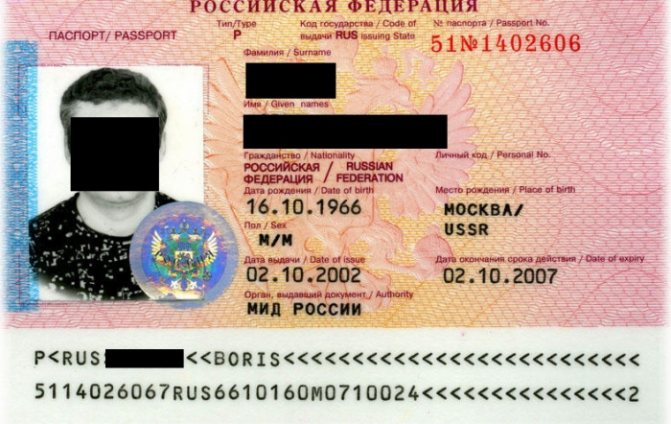
Another difference from the Russian document is that the passport series by region of issue is not registered.
Independent number search
A foreign passport is a very important document. It is used in any situation to identify a Russian citizen outside the Russian Federation. Anyone who has recently drawn up this document knows that there are two types of international passport:
- Old type.
- New, with electronic chips containing biometric data contained in them.
In addition, passports can be diplomatic or official, and for each of them the series and number of the international passport are determined. You can view this data on the main page, where you can find:
- Photo.
- Date of Birth.
- Date of issue and expiration date.
- Other information.
Many travelers do not know how many digits make up a foreign passport number. These are seven digits that together make up a unique code. The number is preceded by a series (in an old type Russian international passport) or class of affiliation (for new type documents).
If you open your passport on the main page, you need to look at the top line. There is a special line “passport number”, under which the owner will notice nine numbers. The first two of them are the class or series, the last seven are the passport number . If you need to indicate or report the document number outside the Russian Federation, you must indicate nine characters in a row.
You should not include information from the bottom of the page. Yes, it contains the same number and additional parameters, but typewritten text is difficult for the average person to understand. Any citizen can get confused and indicate the wrong number.
When is a number required?
When going abroad, be prepared for the fact that you may be asked for the number and series of your foreign passport. Most often this happens in the following situations:
- When filling out a visa application.
- When taking out insurance abroad.
- To register at the place of stay (filling out a migration card).
- When applying for a job.
This is not a complete list of situations. Regardless of the type and pattern of the foreign passport, a citizen can easily find the required set of numbers.
Moscow passport
Since Moscow and the region represent a fairly large territory, several codes are used that indicate the series of the passport. From the above table you can see that Moscow, being a city of federal significance, has a code of 45, and the Moscow region and the Baikonur complex have a code of 46.
Accordingly, the number and series of the Moscow passport may look like: 4506 354657, where 45 is the region code (Moscow), 06 is the year of issue (2006), 354657 is the serial number of the form.
An identification document for a resident of the Moscow region may look like this: 4608 023476, where 46 is the region code (Moscow region), 08 is the year of issue.
Getting the information you need

Sometimes situations arise when you don’t have an identity document at hand, but the data from it is urgently needed. This can happen, for example, when making a call to a bank, and at the other end of the line they ask for such information. Or for tax information through the relevant websites.
If you have documents at hand containing such data, for example, contracts, statements, their photocopies and similar papers, then you can safely use them. Such documents are also suitable for registration on the government services website, as well as other trusted resources.
If the series and number are known
Not many people know that the numbers in a passport are not a random or chaotic set of them. If you know how to decipher and read them correctly, you can find out by whom and when the document was issued without much difficulty or effort. So, it’s worth sorting everything out in order.
The first two digital signs in the series are OKATO (All-Russian Classifier of Objects of Administrative-Territorial Division). Thanks to this knowledge, it is possible to determine the republic, region, and region where the document was issued. As you know, each subject of the country has its own numerical designation. For example, it can be found on all license plates. Information about them is open and accessible.
The following two-digit number indicates the year the document was received. The year is also indicated by the last two digits in the passport number. But it is not always reliable. Sometimes it happens that such data does not match. However, the difference may be only 1 year.
Everything else is just the serial number of the document itself.
Such an analysis of the series and number of the passport, of course, will not provide complete and comprehensive information about the date (date and month), as well as the specific territorial authority of the migration service. However, in some cases, even this approach can make a significant difference.
Valuable information by department code

The passport of a citizen of the Russian state contains information about the unit code. This is a set of six digits grouped in groups of three and separated by a dash. The first number of the first two characters is the designation of the subject of Russia in which the corresponding passport was issued.
The third figure corresponds to the department level: (FMS, internal affairs departments of a city or rural settlement, passport and visa services, etc.):
- unit is the passport and visa service of the Ministry of Internal Affairs, the city department of internal affairs;
- 2 – this is the PVS of the city or district police department;
- the troika is urban and rural branches;
- 0 recently means the issuance of a passport by the migration service.
Now let's look at the second group of numbers. Its set is responsible for the specific department that issued the document. Information about it is difficult to find, but it is still possible. There is no single information base for such. But such data is not secret.
A special case is passports with a division code, where the first digits are 900. Such documents were issued in Crimea until a certain time, when it had not yet been officially annexed to the territory of the Russian state and did not become its full-fledged subject on a par with the city of Sevastopol. Currently, passports with code 910 are issued on the peninsula.
Did you know that if you change your last name after marriage, you need to change your passport? How to check whether a Russian citizen's passport is valid? See here.
What to do if you lost your passport in another city? Read the article.
